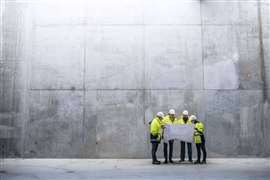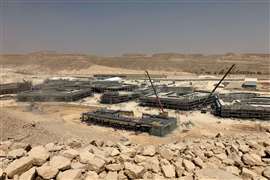Water: a threatened resource in Latin America and the Caribbean
10 December 2009
An inter-American Development Bank study on water resources in Latin America and the Caribbean (LAC).
A COMPETITIVE ADVANTAGE
LAC has 8% of the world's population but controls 31% of total freshwater resources (Asia has 60% of population, only 28% of water). This advantage is evident:
In electricity:
- Water provides 68% of all electricity generation (more than 80% in Brazil) compared to global averages of less than 16%
- Cheap, renewable, carbon-neutral source of power, with room for growth:
- Only around 30% of LAC's total hydroelectric potential has been tapped so far.
In mining:
- LAC earned US$ 68 billion in mineral and metal exports in 2008, but mining requires huge quantities of water.
In agriculture:
- LAC foods exports doubled over the last decade, reaching US$ 100 billion in 2008.
- LAC dominates exports of crops like soybeans (60% of global exports in 2008) and sugar (51%) that require vast quantities of predictable rainfall, and animal protein like beef (50%) and poultry (36%) that feed on large quantities of rain-fed grass or grains.
- In contrast to other regions, where land and water for agriculture are severely constrained, LAC can vastly expand food production (ie: the Near East/ North Africa region uses 53% of its water resources in irrigation, while Latin America barely uses 1%)
1. A THREATENED RESOURCE
Scientists agree that changes in water supply will be among the first and most dramatic impacts of climate change in LAC, because of
- Extreme weather events (droughts, hurricanes, floods) are expected to increase with rising temperatures.
- Accelerated melting of Andean glaciers, which have shrunk by 30% during last 30 years; many could disappear by 2030.
Likely impact on energy:
- In the last 10 years historic droughts have caused critical reductions in electricity production in Brazil, Argentina, Chile, and Peru. Right now, Venezuela and Ecuador are rationing electricity because of the droughts.
Impact on food & exports:
- Drought cost Argentina 1.5 million head of cattle and half its wheat crop in 2008, with financial losses in excess of US$ 3 billion.
- Access to water is now one of the principal constraints to the expansion of mining in countries like Chile and Peru, and a frequent source of conflict with communities near proposed mines.
- Guatemala declared a "state of calamity" this summer because of drought/hunger/malnutrition, and Mexican maize and bean harvests were sharply curtailed.
Impact on health and drinking water:
- Hurricane and floods (like the one that killed 200 people in El Salvador last week) expose millions to unsafe water & disease, especially in the Caribbean
- Droughts have forced Mexico City and Caracas have had to ration water this year
2. A NEGLECTED RESPONSIBILITY
Although LAC is on track to meet the Millennium Development Goals regarding coverage in water & sanitation, the quality of services is severely deficient, and the region is far behind on wastewater treatment:
- 85 million people lack water in their homes, and 115 million lack sanitation
- Many of those who do have water receive it for only a few hours per day
- Tap water is often not potable, leading to growing reliance on bulk bottled water consumption, even among the very poor, and even among those who have a water connection in their home.
- Bulk bottled water sales tripled since 2000, to $3 billion per year
- Mexico now has higher per-capita bottled water consumption that the US and all European countries.
- Many low-income families in urban settings spend around US$ 30 per month on bulk bottled water (sold in 20 litre or 5 gallon water-cooler type bottles). This is often three or four times as much as they spend on their piped water service.
Water-borne diseases still common:
- 38000 children under 5 die each year from diarrhoea.
- Millions suffer from Neglected Tropical Diseases such as intestinal hookworms and roundworms
- Pollution of water sources is out of control:
- Less than 20% of all wastewater is treated before being dumped into rivers and lakes
- Most urban rivers are extremely polluted, exposing millions to toxins and disease
- Cities lose billions in potential revenues from commercial real estate and tourism that is ruined by polluted rivers and bays
- Operators are wasteful and inefficient:
- Average operator only bills for 50% of water it produces (the rest is lots to leakage, theft and non-payment)
- Water meters are not installed or are out of order in tens of millions of homes, as a result, average LAC family consumes twice as much water as one in German and three times as much as one in China.
3. IDB RESPONSE:
Sustainable Energy and Climate Change Initiative
- Pioneering projects to help governments overhaul infrastructure planning to mitigate impacts of climate change.
- US$ 2.6 billion in renewable energy, energy efficiency and climate policy loans and technical cooperation since 2007.
Our Water and Sanitation Initiative
- Annual lending in water/sanitation had fallen to less than US$200 million five years ago.
- In 2007, we set out to finance 100 cities with at least 50000 in habitants and in 3000 rural communities by the year 2011.
- Approvals jump to US$ 850 million in 2007, US$ 1.5 billion in 2008, US$ 1.75 billion in 2009
- Have already financed projects in 112 cities; will easily pass rural targets.
- By 2011, we will have lent at least US$ 6 billion for this sector, extending service to more than 30 million people.
- In July, IDB signed agreement to jointly finance projects with Spain. For every US$ 1 that the IDB puts in, Spain offers US$ 2 or US$ 3 more in grants. IDB brings experience in the region, big pipeline, ability to execute and evaluate.
- Spain and IDB will co-finance projects for US$ 620 million in 12 countries throughout the region, benefitting 4 million people. Spain brings US$ 420 million in grants. We offer the balance in grants, loans, and project preparation costs.
- We recently approved projects in Haiti (US$ 40 million), Bolivia (US$ 100 million) and Paraguay. By mid-2010 will also start joint projects in Uruguay, Brasil, Guatemala, el Salvador, Honduras, Dominican Republic, Costa Rica, Ecuador and Peru.
- Other strategic partnerships: Gates Foundation/Sabin Institute (US$ 137 million trust fund to prevent Neglected Tropical Diseases.) FEMSA Water and Sanitation Scholarship prize. Coca Cola water for rural schools.
STAY CONNECTED


Receive the information you need when you need it through our world-leading magazines, newsletters and daily briefings.
CONNECT WITH THE TEAM










